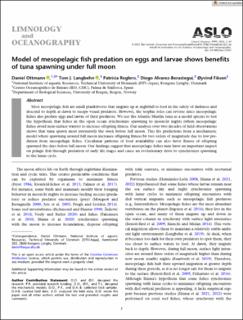| dc.contributor.author | Ottmann, Daniel | |
| dc.contributor.author | Langbehn, Tom | |
| dc.contributor.author | Reglero, Patricia | |
| dc.contributor.author | Alvarez-Berastegui, Diego | |
| dc.contributor.author | Fiksen, Øyvind | |
| dc.date.accessioned | 2024-01-29T13:17:58Z | |
| dc.date.available | 2024-01-29T13:17:58Z | |
| dc.date.created | 2023-12-07T08:16:42Z | |
| dc.date.issued | 2023 | |
| dc.identifier.issn | 0024-3590 | |
| dc.identifier.uri | https://hdl.handle.net/11250/3114327 | |
| dc.description.abstract | Most mesopelagic fish are small planktivores that migrate up at nightfall to feed in the safety of darkness and descend to depth at dawn to escape visual predators. However, the trophic roles can reverse since mesopelagic fishes also predate eggs and larvae of their predators. We use the Atlantic bluefin tuna as a model species to test the hypothesis that fishes in the open ocean synchronize spawning to moon-lit nights (when mesopelagic fishes avoid near-surface waters) to increase offspring fitness. Our analysis over two decades of field observations shows that tuna spawn most intensively the week before full moon. This fits predictions from a mechanistic model where spawning around full moon increases offspring fitness by two orders of magnitude due to low predation from mesopelagic fishes. Circalunar patterns of food availability can also favor fitness of offspring spawned the days before full moon. Our findings suggest that mesopelagic fishes may have an important impact on pelagic fish through predation of early life stages and cause an evolutionary drive to synchronize spawning to the lunar cycle. | en_US |
| dc.language.iso | eng | en_US |
| dc.publisher | Wiley | en_US |
| dc.rights | Navngivelse 4.0 Internasjonal | * |
| dc.rights.uri | http://creativecommons.org/licenses/by/4.0/deed.no | * |
| dc.title | Model of mesopelagic fish predation on eggs and larvae shows benefits of tuna spawning under full moon | en_US |
| dc.type | Journal article | en_US |
| dc.type | Peer reviewed | en_US |
| dc.description.version | publishedVersion | en_US |
| dc.rights.holder | Copyright 2023 The Author(s) | en_US |
| cristin.ispublished | true | |
| cristin.fulltext | original | |
| cristin.qualitycode | 1 | |
| dc.identifier.doi | 10.1002/lno.12465 | |
| dc.identifier.cristin | 2210077 | |
| dc.source.journal | Limnology and Oceanography | en_US |
| dc.source.pagenumber | 2632-2641 | en_US |
| dc.relation.project | EC/H2020/773713 | en_US |
| dc.relation.project | Norges forskningsråd: 294819 | en_US |
| dc.identifier.citation | Limnology and Oceanography. 2023, 68 (12), 2632-2641. | en_US |
| dc.source.volume | 68 | en_US |
| dc.source.issue | 12 | en_US |

